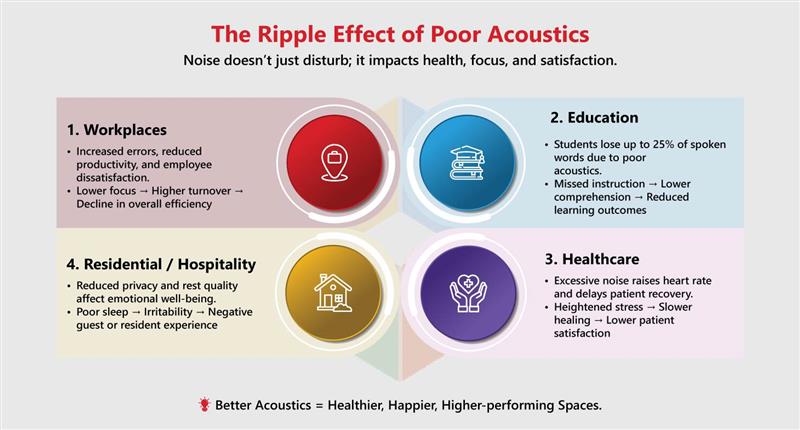
Why Sound Matters More Than Ever
Even in buildings that are meticulously designed today, noise is arguably the most underestimated disruptor of user experience. Architectural firms have mastered daylighting, thermal control, and visual aesthetics; yet they fall behind in space planning and acoustical comfort, addressing it as a finishing detail rather than as a key design component.
Studies show that even moderately elevated background noise levels can:
- Increase stress levels and fatigue – Impacting individual health over time
- Impact attention and cognitive function – Reducing productivity by nearly 15%
- Reduce perceived comfort and satisfaction – Compromising original design intent
This article will evaluate how soundscapes influence well-being within spaces and outline actionable tactics for architecture leaders to consider in the overall approach to designing spaces that sound as good as they look.
Understanding the Science Behind Acoustic Comfort
Acoustic comfort is the balance between appropriate sound and excessive sound. This balance provides an environment that supports focus, rest, and communication.
Health and Cognition:
- WHO notes risks associated with prolonged exposure to noise levels above 55 dB(A), which might consist of cardiovascular health issues, cognitive decline, and increased stress levels.
- Excessive noise negatively affects our limbic system, causing anxiety, loss of attentiveness, and short term memory loss.
The WELL Building Standard contains criteria, such as reverberation control, noise and speech privacy, to improve the health and wellbeing of the occupants in office, education, and health care settings.
Affected Sectors
- Corporate Offices: Noise reduces task accuracy.
- Schools & Education: Noise levels above 35 dB(A) affects learning.
- Healthcare: Quieter spaces support recovery.
- Residential Towers: Sound insulation improves the overall quality of living.
Overall, acoustic wellbeing is crucial to the spaces we design, creating truly human-centric architecture, by listening as much as we design.

Acoustic Comfort: The New Differentiator in Design Excellence
Today acoustic comfort is a key differentiator in design, not simply a consideration of compliance. Clients care deeply about spaces that sound as good as they look and architecture firms are beginning to embrace acoustics into their design DNA.
Building standards such as WELL, LEED, and Fitwel are now prioritizing the acoustic performance of buildings as a measurable factor in occupant health and well-being. This has required design teams to be able to quantify and optimize their design according to measurable factors and objective values including reverberation time, background noise, privacy index, occupancy, etc. as part of the early stages of design.
Many design firms that are maximally leverage acoustic comfort are using early-stage acoustic modeling to predict real-world sound behavior to help them provide workplaces and healthcare facilities where focus, recovery, and comfort can be achieved.
Acoustic comfort design ultimately exemplifies a “people-first” approach to design that builds client trust and elevates the firm’s brand equity around performance-based architecture.
What You Can Do: Concrete Solutions for Better Acoustic Comfort
Making real progress on acoustic comfort happens long before construction. It happens back at the drawing board. For agency owners, it is beneficial to engage with sound design early on to create healthy, high-performing spaces with both clients and occupants take notice of right away. Here's how your team can provide the push to solidify the better acoustic outcomes.
Engage with Acoustic Experts Early
Having sound consultants participate at the concept and schematic stages creates alignment across the ideas on space, materials, and mechanical design, avoiding costly change orders down the line.
Zoning and Plan Space by Use
Plan for functional zoning so that noisy activities like meetings, cafeteria, collaboration, etc., are placed away from quiet (focus, patient) spaces. In many instances, the layout will provide more solutions than the material selection.
Purposefully Choose Materials
Identify sound-absorbing and sound-insulating materials, such as perforated acoustic panels, textile wall systems, and baffles suspended from the ceiling, to manage speech transmission and control reverberation.
Control Building Systems
Incorporate mechanical, electrical, and HVAC noise design strategies as early as possible in the design process. Isolate equipment that is likely to create vibration, and use resilient connections to mitigate structure-borne sound.
Simulate and Validate
Utilize acoustic simulation tools to visualize how sound propagates through your design. Post-occupancy evaluations and user-feedback loops can create a continual refinement of performance for subsequent work.
When architects design with their ears as well as their eyes, the outcome is a much more equitable, peaceful, and human-centered space.
Common Mistakes to Avoid in Acoustic Design
The most beautiful building will still fail if acoustics are addressed late in the planning process. Many design teams tend to overspend and compromise users' comfort by ignoring acoustical planning components.
- Diagnosis Last: Often, if acoustics are considered after the spatial organization, this diminishes design flexibility and increases costs.
- Over-Reliance on Materials: No amount of absorbent finishes can compensate for poor space planning or lack of zoning.
- Not Including Building Systems: Mechanical and HVAC equipment always provide noise levels and vibratory events that might be considered unwelcome background noise.
- Inadequate Coordination: Minimal communication between architects, MEP and acoustic engineers leads to unpredictable performance.
The answer is proactive, data-driven design decisions where sound performance will be modeled, measured and optimized from the first step.
Conclusion
Achieving acoustic performance does not happen by accident. It results from measured performance with shared understanding. For architectural firms, establishing and benchmarking sound quality helps articulate design intent, develop trust, and reflect the desires of an informed client.
Performance benchmarks include:
- Reverberation Time (RT60): Measures how long sound remains audible. Lower values result in clearer hearing in occupational settings like offices, classrooms, or healthcare spaces.
- Speech Transmission Index (STI): Indicates how clearly speech is perceived and understood. Extremely important in collaborative or therapeutic settings.
- Noise Criteria (NC): Measure and consider layering of background noise, specifically from HVAC or mechanical systems, monitored health and comfort levels.
Incorporating these performance metrics into presentation reviews or a post occupancy report conveys a commitment to evidence-based design process. When you can infer a link between acoustic performance criteria to better focus, productivity, or satisfaction, your firm's credibility grows, reinforcing that good design is heard and felt.
